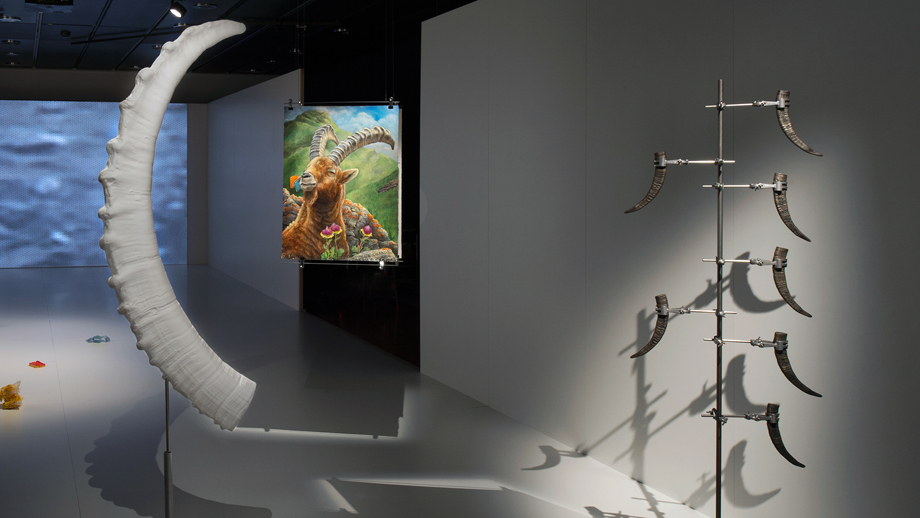Artists Target Ibexes
The video and sound installations, sculptures, and pictures on display at the exhibition aim to build new bridges between art and the natural sciences. Magda Drozd, Nicola Genovese, and Aurélie Strumans, students from Zurich University of the Arts (ZHdK), and the American artist Edward Monovich are showing their work at the Zoological Museum at UZH. The exhibition architecture was designed by scenography student Cornelia Zierhofer. The exhibition is a collaborative project between the artists-in-labs program of the Zurich University of the Arts and the Zoological Museum of the University of Zurich.
Smuggled into Switzerland from Italy
The artists met with evolutionary and wild animal biologists from UZH and the Swiss Federal Institute for Forest, Snow and Landscape Research to explore research into the habitats, behaviours, and genetics of the ibex. The ibex is an animal with a turbulent history: The icon of the Swiss Alps became extinct in Switzerland 200 years ago, and could only be resettled in this country after being smuggled from Italy.
An intimate view of the landscape
The first stop for visitors of the exhibition is the work of Valais artist Aurélie Strumans. Inspired by her foray into the world of ibex research, she chose to focus on the various types of scientific observation. It struck her that scientists always look through binoculars, through a frame. Her thesis is that this individual focus creates privacy and greater intimacy, obliterating the distance between the viewer and the observed object. Aurélie Strumans used her own tool, her camera, to conduct her personal observations in the field. Her video installation plays with images and reveals a surprising fictional dimension to the audience.
Lab noise transformed into music
Artist Magda Drozd visited the evolutionary biologists in their lab at UZH who are researching the genetics of the ibex under the direction of Lukas Keller, director of the Zoological Museum and exhibition curator. Their lab work involves numerous technical processes. Magda Drozd was struck by the precision with which scientists work with the tiniest samples of DNA – and by how repetitive lab work can be. With her sound installation, she reinterprets the visual and auditory material which she gathered in the lab. The noises of the lab are detached from their regular patterns and are transformed into a musical composition.
Biological vulnerability laid bare
American artist Edward Monovich plays on the symbolic idealization of the ibex as “King of the Alps” – for example with an oversized ibex horn created with a 3D printer. Monovich’s work also explores the ibex’s impoverished genetic diversity. His “Genomic Portrait” juxtaposes the animal’s proud-looking appearance with its biological vulnerability. “The data from our genetic research reveals diminished genetic diversity among ibex populations,” explains Lukas Keller. “This means the ibex is less able to respond to environmental changes.”
Echoes of capitalist society
What aroused the interest of Italian-born Nicola Genovese was the way ibex fight. Male ibex battle among themselves in order to define hierarchy and access to the females. “Genovese was very interested in the way the ibex fight, which got him thinking about competition in capitalist society and the way this impacts the ecosystem,” explains Irène Hediger, director of the artists-in-labs program at ZHdK and exhibition curator. This is manifested in Genovese’s work by way of a huge cushion sculpture shaped like an ibex horn and a film projection.
Tracing the creative process
Each artist and the scenographer have their own table at the rear of the exhibition to document their works. They use drawings and personal objects to illustrate their ideas and their exchange with the scientists in the lab and in the field, thereby taking visitors on a mental journey through their research process.
